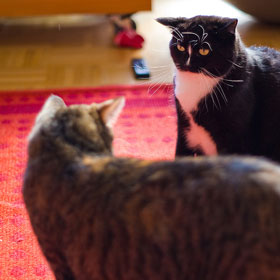Reader Question: Introducing a Trouble-Making Cat into a Stable Cat Household
Veterinary behaviorist Nick Dodman weighs in on the mayhem
caused by the introduction of a trouble-maker into a stable cat household
QUESTION: I have two cats (not from the same litter) who are 8 years old:
Patches (19 lbs.) and Molly (half-Manx around 9-10 lbs.). I also have two
miniature dachshunds Annie and Acee, who are 6 years old. I introduced a new
cat about a month ago, whose name is Cutie. I would say she is around 1 year
old. We live in the country, and she showed up on my back porch (where I feed
several feral cats) wearing a collar but no tag. She is very sweet and loving
to humans, and she seemed so vulnerable; however, she doesn’t like other
cats (except for an aggressive tom cat). Since being in the house, she has
chased Patches three times…now he is terrified of her and hides in the
closet. Molly has wandered out but gets in hissing/growling contests with
Cutie. Additionally, Molly has now stopped eating, but she is diabetic which
is controlled through diet. I don’t want to give up Cutie, but I
don’t know what to do. Molly would start eating again, I’m sure,
if I can just get Patches out of my closet (where she normally eats
uninterrupted). I keep Cutie in the den where my dogs are kept in a crate
during the day and night when I am not home or sleeping. Can you offer any
concrete suggestions? Thank you very much for your help.
Elissa Patadal
~~~
You have indeed got yourself into a pickle by allowing Cutie
into your house. Your resident cats, Patches and Molly, do not appreciate the
newcomer’s intrusion, and their lives have been totally disrupted by it.
It is a fact that not all cats immediately get on together and enjoy each
other’s company. Indeed some seem to have a natural dislike for each other;
that seems to be what’s going on in your home. The best solution would be
to find a new home for Cutie so that Patches and Molly can get their lives
back. Patches is terrified and hiding, and Molly is so anxious that she’s
stopped eating, which is very serious for cats in general and diabetic cats in
particular. If you decide not to take this course, then the only other humane
option is to keep Cutie in a separate part of the house so that she cannot see,
be seen by, or chase your other cats. Over time it may be possible to allow
them to see each other through an inch crack in the door, graduating from this
to some kind of screen, and then to controlled interactions in the same room,
but I would certainly not hurry this process along and would not bank on it
being successful. It seems to me that Cutie and your other cats may just be an
oil-water mix.
Dr. Nicholas Dodman
Head, Animal Behavior Section
Tufts Cummings School of Veterinary Medicine

Not easy advice to take, as finding good homes is so difficult. I agree it's probably for the best (definitely for the resident cats), but I think starting with complete separation is key here (as suggested). Try finding a home for her, but if you can't, try to follow a very gradual and slow course of introductions. Chances are they'll never "be friends", but they may be able to reach some peaceful co-existence.
ReplyDeleteHere's an article about introducing cats to cats, from our website: http://www.thecatsite.com/a/introducing-cats-to-cats
You're also welcome to join our forums and get more help and support from our members. Good luck!
All cat owners with FIV positive cat will want to hear about this. Finally a real treatment for FIV.
ReplyDelete"In addition, Dr. Trauger will be presenting new preliminary findings regarding CytoFeline™, a monoclonal antibody developed for the treatment of FIV. Tests of a panel of anti-LFA1 antibodies against FIV infection in tissue culture showed that certain of these antibodies can block FIV infection. Thus, the Company's original premise that this technology may provide a way to inhibit infection appears to warrant continued developmental research.
The CytoFeline™ research was performed in the laboratory of Dr. John Elder, Professor in the Department of Immunology and Microbial Science at The Scripps Research Institute. "Our preliminary findings are very promising. We can now proceed with additional efficacy tests to determine the practicality of anti-LFA1 antibodies to lower viral loads in FIV-infected cats," commented Dr. Elder"